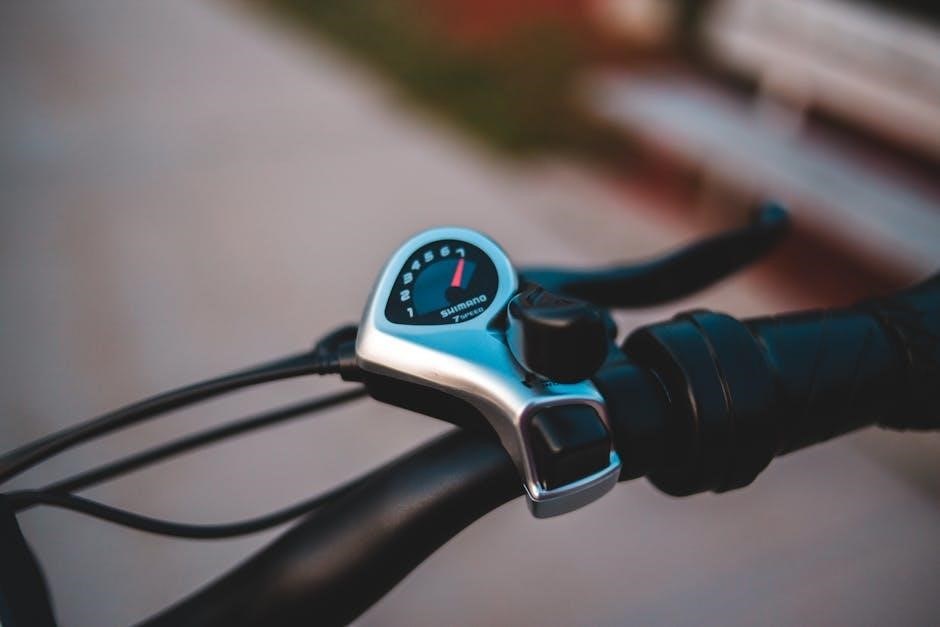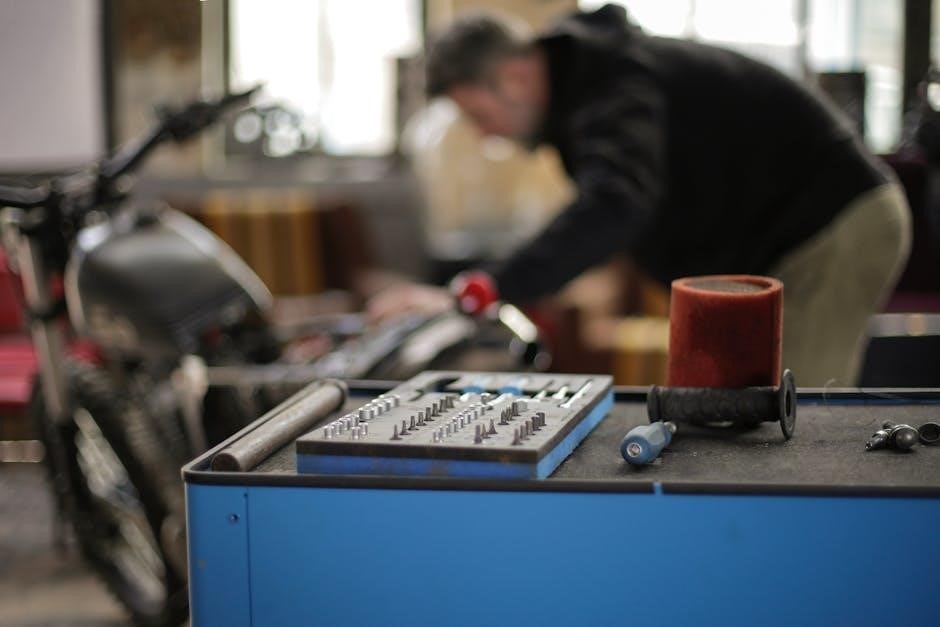
e bike controller manual
An e-bike controller manual is essential for understanding and safely operating your electric bike’s control system‚ ensuring optimal performance and longevity of the vehicle’s components.
1.1 Understanding the Role of a Controller in an E-Bike
The controller acts as the brain of your e-bike‚ managing power distribution between the motor‚ battery‚ and throttle. It ensures efficient energy flow‚ regulates speed‚ and integrates safety features like regenerative braking. Understanding its function is crucial for optimizing performance and maintaining your electric bike’s longevity.
1.2 Importance of Reading the Manual Before Use
Reading the e-bike controller manual is crucial for safely operating your electric bike. It provides essential information on settings‚ troubleshooting‚ and maintenance‚ ensuring optimal performance and longevity. The manual also helps users understand legal and safety standards‚ preventing potential damage to components and ensuring compliance with local regulations.

Safety Precautions and Procedures
Safety precautions ensure proper handling and operation of e-bike controllers‚ preventing damage and hazards. Always follow guidelines to maintain rider safety and system longevity.
2.1 General Safety Guidelines for E-Bike Controllers
Adhering to safety guidelines is crucial for e-bike controller operation. Avoid exposing the controller to water‚ as it can cause short circuits. Ensure all connections are secure and free from damage. Never modify or tamper with the controller’s components‚ as this can lead to malfunctions. Always follow the manufacturer’s instructions for installation and maintenance to ensure safe and reliable performance.
- Avoid water exposure to prevent short circuits.
- Ensure all connections are secure and undamaged.
- Do not modify or tamper with controller components.
- Follow manufacturer instructions for installation and maintenance.
2.2 Pre-Ride Checks and Battery Management
Before each ride‚ inspect the e-bike’s battery and controller connections for damage or loose wires; Ensure the battery is fully charged and securely mounted. Avoid overcharging‚ as it can reduce battery lifespan. Check the display for error messages and test the throttle and brakes. Regularly clean and maintain the battery terminals to prevent corrosion and ensure reliable performance.
- Inspect battery and connections for damage or wear.
- Ensure battery is charged and properly secured.
- Avoid overcharging to prolong battery life.
- Check for error messages on the display.
- Clean and maintain battery terminals.
Components of an E-Bike Controller
An e-bike controller consists of key components like the display‚ throttle‚ and brake levers‚ which work together to regulate power‚ monitor performance‚ and ensure safe operation.
- Display: Shows speed‚ battery level‚ and mode.
- Throttle: Controls power delivery to the motor.
- Brake levers: Often integrate regenerative braking.
- Wiring and connections: Essential for system communication.
3.1 Overview of Key Parts: Display‚ Throttle‚ and Brake Levers
The display provides essential data like speed‚ battery level‚ and mode‚ while the throttle controls power delivery. Brake levers often integrate regenerative braking‚ capturing energy for the battery. These components work together to ensure smooth‚ efficient‚ and safe operation of the e-bike‚ with customizable settings available for personalized performance and enhanced rider experience.
3.2 Understanding Wiring Diagrams and Connections
Wiring diagrams illustrate the connections between the controller‚ motor‚ battery‚ and sensors. Color-coded wires and symbols help identify components. Proper connections ensure safe and efficient operation. Always disconnect the battery before modifying wiring to prevent short circuits. Refer to the diagram for specific setups‚ and follow safety guidelines to maintain system integrity and optimal performance.
Installation and Wiring Guide
Start by mounting the controller securely‚ ensuring proper ventilation. Follow the wiring diagram for connections‚ checking compatibility with your e-bike’s motor and battery. Always disconnect the battery before starting work to prevent electrical hazards. Refer to the manual for model-specific instructions and safety precautions to ensure a successful installation.
4.1 Step-by-Step Installation Process
Begin by preparing tools and ensuring the battery is disconnected. Mount the controller in a secure‚ ventilated area. Connect the motor‚ battery‚ and sensors following the wiring diagram. Verify all connections for tightness and correctness. Reconnect the battery and test the system at low power. Ensure proper functionality before full operation. Refer to the manual for specific torque and connection guidelines to avoid damage or electrical issues.
4.2 Model-Specific Instructions and Variations
Model-specific instructions vary by manufacturer‚ with brands like Yamaha and Bosch offering detailed manuals tailored to their systems. Ensure compatibility by referencing the correct guide for your controller. Check online portals for brand-specific resources‚ such as Yamaha’s Power Assist Bicycle manual or Bosch’s drive system guides. Follow assembly videos and troubleshooting tips for precise installation and operation tailored to your e-bike model.
Maintenance and Troubleshooting
Regular maintenance ensures longevity. Clean connectors‚ inspect wires‚ and store the controller in a dry environment. Troubleshoot issues like error codes or connectivity problems by checking firmware updates or consulting the manual for specific solutions.
5.1 Regular Maintenance Tips for Longevity
Regular maintenance is crucial for extending the lifespan of your e-bike controller. Clean connectors and terminals to prevent corrosion‚ and inspect wiring for damage or wear. Ensure the controller is stored in a dry‚ cool environment to avoid moisture damage. Periodically update firmware to access new features and improvements. Check for error codes and address them promptly to prevent system malfunctions. Proper care ensures reliable performance and longevity.
5.2 Common Issues and How to Resolve Them
Common issues with e-bike controllers include error codes‚ connectivity problems‚ and power cuts; Check wiring connections for damage or corrosion and ensure all components are securely plugged in. Reset the controller by disconnecting the battery and reconnecting it after 30 seconds. For persistent issues‚ consult the manual or contact customer support. Regular updates and proper storage can prevent many problems.

Advanced Settings and Customization
Advanced settings allow customization of speed limits‚ power output‚ and regenerative braking. Programming features enable personalized performance‚ ensuring the e-bike operates according to rider preferences and local regulations.
6.1 Adjusting Speed Limits and Power Settings
Adjusting speed limits and power settings on your e-bike controller allows for customized performance. Refer to your manual for specific instructions‚ as processes vary by model. Most controllers require accessing the settings menu via the display or external tools. Adjustments optimize power delivery and speed‚ ensuring safe operation and compliance with local regulations. Always follow manufacturer guidelines to avoid damage and maintain efficiency.
6.2 Programming Features for Personalized Performance
Modern e-bike controllers often include programmable features‚ allowing riders to customize settings like torque‚ pedal assist levels‚ and regenerative braking. These adjustments can be made via USB-connected tools or dedicated apps. Programming enables tailored performance‚ enhancing ride comfort and efficiency. Always refer to your manual for specific instructions to avoid errors and ensure optimal functionality.

Legal and Environmental Considerations
Compliance with local e-bike regulations is crucial. Proper disposal of components like batteries and controllers ensures environmental safety. Always follow regional guidelines for eco-friendly practices.
7.1 Compliance with Local E-Bike Regulations
Ensure your e-bike meets local laws‚ including speed limits and age restrictions. Familiarize yourself with regulations regarding bike paths and road use. Proper documentation and adherence to safety standards are essential. Non-compliance may result in fines or restrictions. Always verify requirements before modifying your e-bike’s controller or components to maintain legality and safety.
7.2 Proper Disposal of E-Bike Components
Properly dispose of e-bike components‚ such as batteries and controllers‚ through environmentally responsible methods. Recycle hazardous materials like lithium-ion batteries at designated facilities. Avoid disposing of electronic parts in regular trash to prevent environmental harm. Consult local recycling centers for guidance on eco-friendly disposal practices‚ ensuring compliance with environmental regulations and safeguarding natural resources.
Manufacturer-Specific Manuals
Manufacturer-specific manuals provide detailed instructions tailored to brands like Bosch‚ Yamaha‚ and others‚ ensuring compatibility and optimal performance for their unique e-bike systems and controller configurations.
8.1 Bosch‚ Yamaha‚ and Other Popular Brands
Manufacturer-specific manuals for brands like Bosch and Yamaha provide detailed guidance on their advanced e-bike systems. Bosch manuals cover Performance Line CX and Speed models‚ while Yamaha details Power Assist features. Other brands like Grinfineon and Kelly offer manuals with custom firmware and maintenance tips‚ ensuring compatibility and optimal performance for their unique controller configurations and e-bike systems.
8.2 Accessing and Downloading Official Manuals
Official controller manuals for popular brands like Bosch and Yamaha are available on their websites or through dedicated portals. Users can search by model or product name to find specific guides. Many manufacturers‚ such as Grinfineon and Kelly‚ offer downloadable PDFs with detailed instructions. Ensure to download the latest versions for accurate and up-to-date information tailored to your e-bike’s components and systems.

User Resources and Support
Online forums‚ manufacturer websites‚ and customer support teams provide essential resources for troubleshooting and optimizing your e-bike controller. Stay informed with updated guides and community advice.
9.1 Online Communities and Forums for E-Bike Enthusiasts
Online forums like Endless-Sphere and Electric Bike Forums offer valuable resources for e-bike enthusiasts. These platforms provide troubleshooting tips‚ customization ideas‚ and real-world experiences from riders. Users can share knowledge‚ resolve issues‚ and learn about the latest trends in e-bike technology. Engaging with these communities fosters a supportive environment for both beginners and advanced riders‚ ensuring optimal use of their e-bike controllers.
9.2 Contacting Customer Support for Assistance
Reaching out to customer support is crucial for resolving complex issues with your e-bike controller. Most manufacturers‚ like Bosch and Yamaha‚ provide dedicated support teams and online resources. Users can access troubleshooting guides‚ submit tickets‚ or contact via email/phone for personalized assistance. Always refer to the official website for accurate contact information and ensure your query is detailed for efficient support.
Always follow guidelines‚ perform regular checks‚ and stay informed to maximize your e-bike experience and ensure safe‚ efficient operation for years to come.
10.1 Maximizing Your E-Bike Experience
To maximize your e-bike experience‚ ensure proper controller setup‚ follow maintenance routines‚ and explore customization options. Regularly update firmware‚ adjust power settings‚ and monitor battery health. Familiarize yourself with safety features and riding modes to optimize performance. Customizing settings like speed limits and regenerative braking can enhance your ride. Always refer to your manual for model-specific tips to ensure a safe‚ efficient‚ and enjoyable journey.
10.2 Staying Updated with the Latest Developments
Stay informed about the latest updates in e-bike technology by regularly checking manufacturer websites for firmware updates and new features. Subscribe to official newsletters and join online communities to stay updated on best practices and troubleshooting tips. Accessing updated manuals and guides ensures you benefit from improvements and enhancements‚ keeping your e-bike performing at its best.